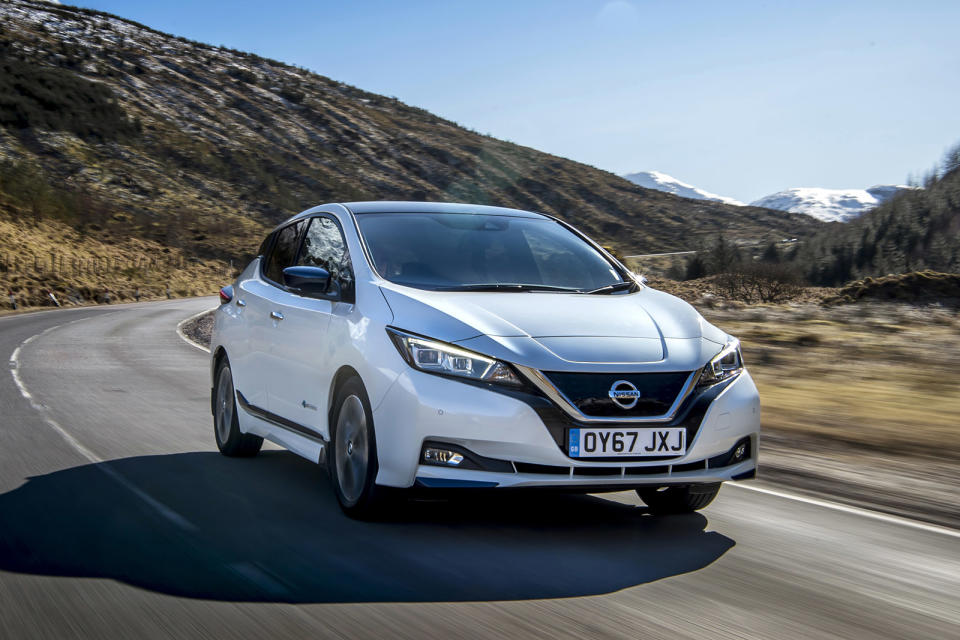Nissan Leaf

The Nissan Leaf is the electric car with the name that’s always spelled out in block capital letters on all the advertising billboards: and here’s why. Because the name of the world’s best-selling EV is actually an acronym. Turns out they didn’t just dub it in honour of former Nissan boss Carlos Ghosn’s favourite rubber tree pot plant after all.
It’s an usually descriptive acronym by Japanese car-industry standards: this car is Nissan’s ‘Leading Environmentally friendly Affordable Family vehicle’. Of course it is.
While it takes a bit of a fudge to turn that into the acronym in question (‘LEFAFV’ doesn’t have quite the same ring), the contrivance neatly conveys the car’s central truth: that any Leaf must be more practical, convenient, good-value and easy-to-operate than any other electric vehicle. And yet it must also be market-leading: popular in one sense, innovative and pioneering in another.
Thus far, it’s been fairly straightforward for Nissan to define the Leaf as the ‘leading’ EV because, well, they’ve sold a quarter-of-a-million of them. Looking towards a fairly near future with all-electric Hondas, Toyotas, Volkswagen IDs and countless millions of Teslas in it, however, ‘market-leading’ status may be a tougher ask.
Still, it’ll be the fibre of this car with which it’ll be aiming to claim it: the second-generation Nissan Leaf, complete with sharper looks, more power, more battery range, better onboard technology – and a value-for-money proposition that plainly isn’t to be sniffed at.
Where the second-gen Leaf improves on the original
On the face of it, certainly a ‘LEAF’ that continues to be worthy of those capital letters. Having increased this car’s battery range by 50%, motor power by 40% and torque by 25%, the company has actually reduced prices on the Nissan Leaf by up to £1500, depending on trim level.
Granted, the car still relies on the UK treasury’s £4500 buyer incentive to make good its business case. But taking that deal into account, the bottom-rung Leaf now comfortably beats an entry-level combustion-engined Audi A3 Sportback on power, performance and list price, regardless of whether you prefer the Audi in petrol or diesel form.
Where the Leaf falls down when compared with the proper premium-branded mainstream hatchbacks against which it’s priced continues to be inside. The car’s driving position is improved but still feels oddly perched (because you’re sitting, even up front, directly above the drive battery) and still lacks telescopic steering column adjustment. Perceived cabin quality’s a shade improved from the outgoing 2011-2017 Nissan Leaf’s standard but it’s still way off where it ought to be for the price.
At least you get a better instrument cluster this time around, from the base Visia model up. The digital screen has a display you can customise, which makes getting the best out of that electric powertrain that much easier.
Entry-level cars also come with 16in steel wheels, halogen headlights and LED daytime running lights, electric windows, lane departure and blind spot warnings, and manually adjustable seats. Stepping up to the Acenta adds 16in alloy wheels, front fog lamps, a leather steering wheel, cruise control and a 7in infotainment system with Android Auto and Apple Carplay.
The mid-range N-Connecta includes 17in alloys, electric folding wing mirrors, synthetic half-leather seats, auto-dimming rear-view mirror, and object-detecting 360-degree parking cameras. The top-end Techna model gains full LED headlights, black leather interior, heated seats and steering wheel, an electronic parking brake, and a 7-speaker BOSE sound system, as well as Nissan's ProPilot semi-autonomous drive modes.
Behind the wheel of the Nissan Leaf
Driving the Leaf is certainly suggestive of greater premium-level refinements than the interior is. Being as brilliantly responsive to the accelerator as ever, and having greater torque-related thrust below about 50mph than just about anything short of a hot hatchback, the Leaf is a delight to drive around town. Nissan’s powertrain improvements also make it feel much less out of place on the motorway than the old one did.
There’s a new ‘ePedal’ setting for the car, which filters in strong regenerative braking before you go anywhere near the brake pedal, and makes the Leaf at once easier to drive and better at recycling energy than the old one. And, perhaps more striking than everything else, this is now a seriously quiet and refined car – just as you’d want an EV to be.
The Leaf is based on an overhauled version of the old car’s mechanical platform but, having been made torsionally stiffer than its predecessor as well as quicker-steering and more resistant to body roll, it feels both comfortable-riding and fairly agile-handling on the road: enough in both cases, certainly, to satisfy most tastes. There’s well-tuned weight and return-to-centre springing about the steering too.
Even in light of all that, though, while the original Leaf wasn’t a car an interested driver would pick above its rivals, the new one probably isn’t either. It’s a car designed, from a dynamic standpoint, to do everything to a consistent eight-out-of-ten standard, rather than any one thing brilliantly. And it’s a success in that respect.
If you think you’re ready for an EV, few would make a better route in. Those who decide to will continue to do so for rational reasons: because the Leaf’s better-priced than its opponents, better-supported by relevant public fast-charging infrastructure, more practical – and because it now has the battery range to be more usable than it ever used to be.
At an ‘NEDC’-certified 235 miles, the new Leaf’s cruising range beats that of every rival save the priciest Renault Zoe (250 miles) and the Opel Ampera-e (323 miles, though it’s denied to UK buyers).
Our test drive suggested you should expect more like 160-170 miles from this car between charges, in mixed real-world use. Relative to the claim, that may sound like a con - but it’s actually quite impressive for what remains one of the juvenile EV class’s value champions.
]]>

 Yahoo Autos
Yahoo Autos 